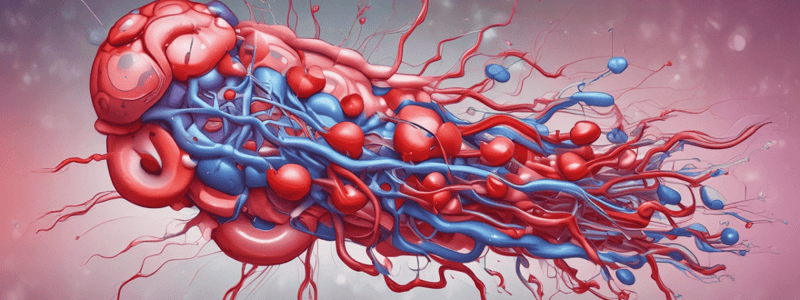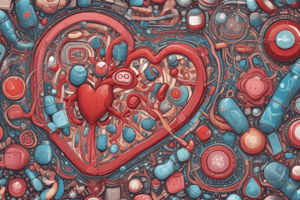Podcast
Questions and Answers
What is the mechanism of action of diuretics?
What is the mechanism of action of diuretics?
- Blockade of Na and chloride reabsorption (correct)
- Increase potassium excretion
- Increase sodium retention
- Enhance water absorption
Loop diuretics are effective in patients with renal impairment.
Loop diuretics are effective in patients with renal impairment.
False (B)
What are some of the adverse effects of loop diuretics?
What are some of the adverse effects of loop diuretics?
Low Na/Cl, dehydration, hypotension, low K, ototoxicity.
Which of the following is NOT a use for thiazide diuretics?
Which of the following is NOT a use for thiazide diuretics?
What is a common drug interaction concern with ACE inhibitors?
What is a common drug interaction concern with ACE inhibitors?
The primary action of ARBs is to block the actions of __________.
The primary action of ARBs is to block the actions of __________.
Which of the following adverse effects is associated with calcium channel blockers?
Which of the following adverse effects is associated with calcium channel blockers?
Match the following drugs with their classifications:
Match the following drugs with their classifications:
Direct renin inhibitors can cause cough as a side effect.
Direct renin inhibitors can cause cough as a side effect.
Which medication is often used for hypertensive crises?
Which medication is often used for hypertensive crises?
Which two antihypertensive drugs are preferred during pregnancy?
Which two antihypertensive drugs are preferred during pregnancy?
Flashcards are hidden until you start studying
Study Notes
Diuretics
- Blockade of Na and chloride reabsorption in the nephron
- Can cause hypovolemia, acid-base imbalance, and electrolyte loss
Loop Diuretics
- Act on the ascending loop of Henle to block reabsorption
- Uses: pulmonary edema, edema, hypertension, and good for renal impairment patients
- Adverse effects: low Na/Cl, dehydration, hypotension, low K, ototoxicity
- Interactions: digoxin (increases K), ototoxic drugs, potassium-sparing diuretics, lithium (accumulation), anti-hypertensives, and NSAIDs (blunt effects)
Thiazide Diuretics
- Renal excretion of Na, Cl, K, and water
- Uses: hypertension, edema, and diabetes insipidus
- Adverse effects: low Na/Cl/K, dehydration, hyperglycemia, hyperuricemia, impact on lipids, Ca, and Mg
- Elevate uric acid and glucose levels
- Interactions: same as above, except not ototoxic
- Not effective in patients with renal impairment
- Maximized diuresis is lower than loop diuretics
Potassium-Sparing Diuretics
- Aldosterone antagonist: spironolactone
- Blocks aldosterone in the distal nephron
- Uses: hypertension, edema, heart failure, and hyperaldosteronism
- Adverse effects: high K, tumors, gynecomastia, menstrual irregularities, impotence
- Interactions: thiazide/loop, agents that raise K (ACE, ARBs, and K supplements)
- Non-aldosterone antagonist: triamterene and amiloride
- Modest increase in urine production, decreases K excretion
- Uses: hypertension and edema
- Adverse effects: high K, leg cramp, nausea/vomiting, blood dyscrasias
Drugs of RAAS
ACE Inhibitors
- Block production of angiotensin II, increase levels of bradykinin
- Inhibit angiotensin II: dilate blood vessels, reduce blood volume, prevent/reverse pathologic changes in the heart and blood vessels, hyperkalemia, and fetal injury
- Bradykinin: vasodilation, cough, angioedema
- All excreted by the kidneys
- Administered orally with food (captopril and moexipril)
- Enalapril IV
- Captopril prolongs half-life
- All except lisinopril are prodrugs that must undergo conversion to active form in small intestines and liver
- Ramipril reduces risk of MI, stroke, and death from CV
- Benazepril, perindopril, and trandolapril available combined with calcium channel blockers
- Dosages for all ACE (except fosinopril) should be reduced in renal patients
- Uses: hypertension, heart failure, myocardial infarction, diabetic nephropathy, and diabetic retinopathy
- Adverse effects: first-dose hypotension, cough, hyperkalemia, angioedema, neutropenia, and renal failure in patients with bilateral renal artery stenosis
- Interactions: diuretics may intensify first-dose hypotension, caution with potassium-sparing drugs, can cause lithium to accumulate to toxic levels, and NSAIDs may reduce anti-hypertensive effects
ARBs
- Blocks actions of angiotensin II
- Uses: hypertension, heart failure, diabetic nephropathy, and prevention of MI/stroke/death from CV
- Much like ACE inhibitors but ARBs pose lower risk for cough or hyperkalemia
- ACE inhibitors are preferred for CV, but ARBs are a second choice
- Adverse effects: angioedema, renal failure, and fetal injury
- ARBs do not promote accumulation of bradykinin in the lung, which leads to a lower instance of cough
Direct Renin Inhibitors (DRIs)
- Act on renin to inhibit the conversion of angiotensinogen into angiotensin I
- Suppress the entire RAAS
- Aliskiren (only available)
- Blood pressure reduction, less cough/angioedema/hyperkalemia, similar risk to developing fetus
- Approved only for hypertension
- Adverse effect: diarrhea
Aldosterone Antagonists
- Spironolactone (diuretic)
- Add-on therapy in hypertension and class III-IV heart failure, edema in cirrhotic adults, hyperaldosteronism, and nephrotic syndrome
- Has anti-androgenic properties, off-label use for hirsutism, female pattern hair loss, and acne
- Eplerenone (diuretic)
- Aldosterone receptor blockers
- Uses: hypertension and heart failure
- Adverse effects: hyperkalemia, diarrhea, abdominal pain, cough, fatigue, gynecomastia, and flu-like symptoms
- Interactions: inhibitors of CYP can increase levels of eplerenone, toxicity
Calcium Channel Blockers
-
Act on vascular smooth muscle and the heart
-
Block Ca contraction, prevent vasodilation, and result in vasodilation
-
Work on arteries, not veins
-
Verapamil: (nondihydropyridine)
- Acts on arterioles and the heart
- Uses: angina, hypertension, and dysrhythmias
- Dilation, increases coronary perfusion, reduces HR (blocks SA), decreases conduction (blocks AV), and decreases force of contraction (blocks myocardium)### Calcium Channel Blockers (CCBs)
-
Verapamil:
-
Vasodilation and increased coronary perfusion
-
Adverse effects (AE): constipation, LE edema, gingival hyperplasia, flushing, HA, bradycardia, and partial or complete AV block
-
Interactions: with digoxin risk for AV block, with BB excessive cardio suppression, and with grapefruit juice can increase levels
-
Diltiazem:
-
Same as verapamil, but less constipation
-
Nifedipine:
-
Works on vascular smooth muscle vasodilation, including coronary perfusion
-
Less blockade of Ca, heart rate, and contractile force increases
-
Not used for dysrhythmias, does not cause cardiac suppression, and less likely to exacerbate pre-existing cardiac disorders
-
AE: flushing, HA, edema, gingival hyperplasia, and eczematous rash in elderly
-
Reflex effects occur primarily with immediate-release formulation, can cause reflex tachycardia
Vasodilators
- Uses: HTN, HTN crisis, angina, HF, MI
- Act directly on smooth muscle in arterioles and veins to produce vessel relaxation
- AE: postural hypotension
- Hydralazine:
- Dilation of arterioles, peripheral resistance and arterial bp fall, HR and myocardial contractility increase
- Hydralazine-induced tachycardia, give with BB
- Hydralazine-induced hypotension, Na/water retention increases in blood volume, a diuretic can help
- Can cause acute rheumatoid syndrome that resembles SLE (lupus)
- Symp are reversible but take 6mo or more
- Minoxidil:
- More intense vasodilation than hydralazine and causes severe AE
- Reserved for patients with severe HTN not responding to safer drugs
- Uses: HTN only, helps with hair growth (hypertrichosis)
- Same as hydralazine
Anti-hypertensives
- Dilation of arterioles and veins
- AE: hypotension, sedation, and all antihypertensives interfere with sexual dysfunction
- Can give: diuretics, calcium channel blockers, ACE, and ARBs
- For initial therapy with the absence of a compelling indication: thiazide diuretic
- Comorbid conditions that complicate tx: renal disease (nephrosclerosis) and DM
- Nephrosclerosis: ACE and ARBs
- DM: all work with dm nephropathy ACE and ARBs can slow renal damage and reduce albuminuria
- When needing to add combination therapy: ACE plus thiazide diuretic, ACE plus CCB, or BB plus thiazide
- With pregnancy:
- W/ exception of ACE, ARBs, and DRIs, anti-HTN drugs that were taken before pregnancy can be continued
- When initiated during pregnancy: methyldopa and labetalol are of choice
- Preeclampsia and eclampsia: hydralazine and mag sulfate
Studying That Suits You
Use AI to generate personalized quizzes and flashcards to suit your learning preferences.




